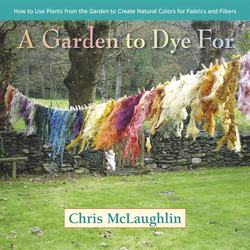Читать книгу A Garden to Dye For - Chris McLaughlin - Страница 12
На сайте Литреса книга снята с продажи.
Gardeners and the Plants That Love Them
ОглавлениеToday, America is making a wise shift towards natural and organic practices. In fact, many people (maybe even you) are designing their entire lifestyle around natural and organic. You may have already guessed that there are some great perks that come with obtaining dyes from your own plants: they’re non-toxic, biodegradable (compost anyone?) and absolutely renewable.
Using botanical dyes isn’t even remotely close to being a new concept. People from all over the world have been borrowing nature’s colors for thousands of years, using plant-based dyes to adorn clothing, baskets, cave walls, and skin. It’s the ultimate in awesome to realize that when we derive color from the plants in our gardens or landscapes, we’re communing creatively with our ancient ancestors and civilizations.
Another natural by-product of your new hobby is that your actions will align perfectly with others who have similar values that you do as a gardener. Slow movement folks, handcrafters, artisans, and the home gardener . . . all share a love to some degree for less environmental impact, good health, nature – as well as for the human experience and creative expression.
As a plant person, I can’t think of a better group of people to create natural dyes than gardeners. Not only do we already have creativity and experimentation in our blood, but we know how to work with and not against the best parts of nature. We understand that time is perhaps a garden’s best friend; and it’s the same for the dye pot. We’ve already learned to appreciate every season in the garden.
We know that what starts out as young and vibrant may gracefully fade, bringing a new landscape that’s perhaps less vivid than the last, but just as lovely. Natural color can evolve in the same way on our textiles, too. Gardeners have, quite simply, the right heart for the craft. Plus, I doubt that any of you will be able to resist it.
Many of you are crafters in your own right and are always looking for new ways to incorporate your love for gardening into . . . well, everything else in your life. Hand spinners, knitters, crocheters, fabric weavers, basket weavers, and sewers will all find natural dyes useful. If you have yet to discover these particular arts, there’s always paper, tie-dye T-shirts, curtains, linens – and don’t forget, beautiful scarves and playsilks just begging for natural color!
Healthy Hues? Good Question!
I was also thinking about all of the current evidence about how our skin readily absorbs the everyday chemicals that we place both on and around our bodies and the health issues they pose. If that’s true, then couldn’t it also be true with the plant dyes?
When we wear textiles and our kids play with textiles colored with natural dyes, could we be absorbing the healthy properties of our herb plants? I certainly don’t have definitive answers, but it does stand to reason and brings up exciting questions.
In fact, this is a brand new area of study and The University of Derby in the UK seems to be quite interested in the topic. Dr. Kate Wells, Senior Lecturer in Textiles at the university, is investigating whether garments dyed using traditional, natural colorings (like indigo, woad, turmeric and henna) can directly improve our physical wellbeing by their contact with the skin. In a research paper published in the Journal of the International Colour Association, she writes: “Historically many dye plants were once regarded to have “magical” properties, with the power to heal and to keep evil away. Today many of these plants that can be used for dye extraction are classified as medicinal and in recent studies have been shown to process remarkable anti-microbial, anti-fungal, anti-viral activity.”
Create some gorgeous wearable art.
To encourage more research on the subject, Dr. Wells asks the question, “What possibilities exist within the chemical nature of certain natural dyes to help with healing and well-being, and in the future will we be wearing clothes dyed with such colours from nature that we will be able to enhance our wellbeing as well as be fashionable?”
Go, Kate!
